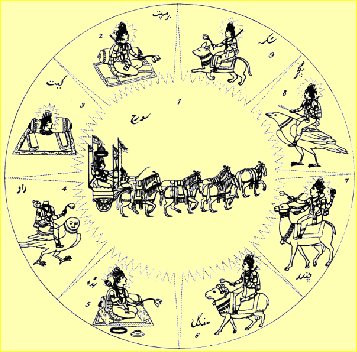





Image
from Moor. Image by permission.
Basic Description: The
Nine Planets consist of: Surya (the sun), Brahmanaspati (Jupiter), Ketu (Dragon's
tail), Rahu (Dragon's head), Budhan (Mercury), Mangal (Mars), Chandra (the moon),
Shanee (Saturn), and Shukra (Venus).
Alternate Names: Navagraha
History/Practices:
The
nine planets play an important role in Hindu religion. Their locations in the
sky have a significant impact upon the fortune of individuals. Each of the planets
is said to benefit humans in a particular way. Vedic Astrology studies the planets
and their affects upon humans. Vedic astrology traditionaly uses the sun, moon,
the five visible planets, and two lunar nodes to comprise the nine planets.
The position of the stars and the date of one's birth are said to have a large
influence on the history of one's life. To placate any undesirable constellations,
often a Shanti propitiation ceremony is given. When created in temples, statues
of the nine planets stand in a square. Surya, the sun-god, stands in the middle,
always facing east. The other statues are situated looking in one of the four
directions such that they do not view each other. Seven of the planets also
give rise to the Vedic names for the days of the week.
Consort:
Surya's consort is Ushas; Budhan's consort
is Menu; Chandra's consort is Rohini, he also loved Tara (the consort of Brahmanaspati)
and kidnapped her, it is also said that he married 27 of Daksha's daughters;
Brahmanaspati's consort is Tara
Sources:
Dallapiccola, Anna L. Dictionary of
Hindu Lore and Legend. New York: Thames & Hudson Ltd, 2002.
Moor, Edward.
The Hindu Pantheon. Los Angeles: Philosophical research society,
1976.
Thomas, P. Epics, Myths
and Legends of India. Bombay, India: D. B. Taraporevala Sons &
Co. Private Ltd, 1961.





